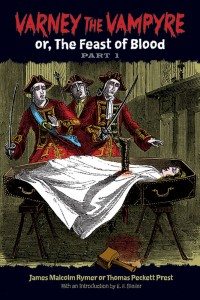
James Malcolm Rymer or Thomas Peckett Prest
Dover Publications
April 15, 2015
Reviewed by Elaine Pascale
If you haven’t seen me in many moons, it’s because I have been reading the epic tome Varney the Vampire. E. F. Bleiler, in his introduction to the two volumes, calls Varney, “the most famous book that no one has read”. This is entirely true: I have taught vampire seminars at the college level, have written many theses on Dracula, have campaigned against Twilight as if it were the plague, and this was my first venture into Varney, although I had heard it mentioned many times. After slogging through it, I now understand why it might be often overlooked.
Varney was a serialized Penny Dreadful, and it is no wonder that few have sat down to consume it as a novel or two part-novel — it was not meant to be digested that way. It contains some gothic scares and standbys — a hidden passageway, a character that resembles a long deceased man of the estate, a damsel in distress, and dark and stormy nights.
Varney is a vampire that contains some, but not all, of the vampire traits and mythology. He has fangs, bites his victims’ necks, and leaves two tell-tale holes. Yet he can walk around during the day, can eat and drink. He is one of the very first sympathetic vampires, as he laments his cursed state. Varney is not really likeable or unlikeable, he is simply the central plot twist. Oddly, the other characters recognize that a vampire is in their midst early on, and then spend a lot of time remarking on how remarkable it is that a vampire is in their midst.
Scholars have argued the authorship of Varney; it has come down to a draw between James Malcolm Rymer and Thomas Peckett Prest. From a reader’s perspective, it feels like there may be more than one author as there is very little continuity, and even Varney’s history/story changes throughout. At times, he is an ancient supernatural creature, at others he is modern and human.
Tackling these two volumes feels like a herculean feat, yet Varney the Vampire is a story of historical significance, both in its being the first full-length vampire story, and in its original mode of distribution. If you can imagine reading it in fragments, in front of a fireplace, with likeminded “gothic soap opera” fans, it does include moments of intrigue and excitement. I recommend Varney the Vampire to vampire purists and fans of the historic gothic novel.









Between ca. 1983 and the present, I have read VARNEY three times, and just finished whittling it down to about 436,000 words. Having also read “The Vampyre” (both short story and opera), CARMILLA, and DRACULA, my vote goes to VARNEY hands down as the best vampire story of 19th century England.
@Phyllis Karr it is engaging!
What would the overall resolution be in volume 1 ?
@kim it’s been so long since I’ve read that I don’t remember. Sorry